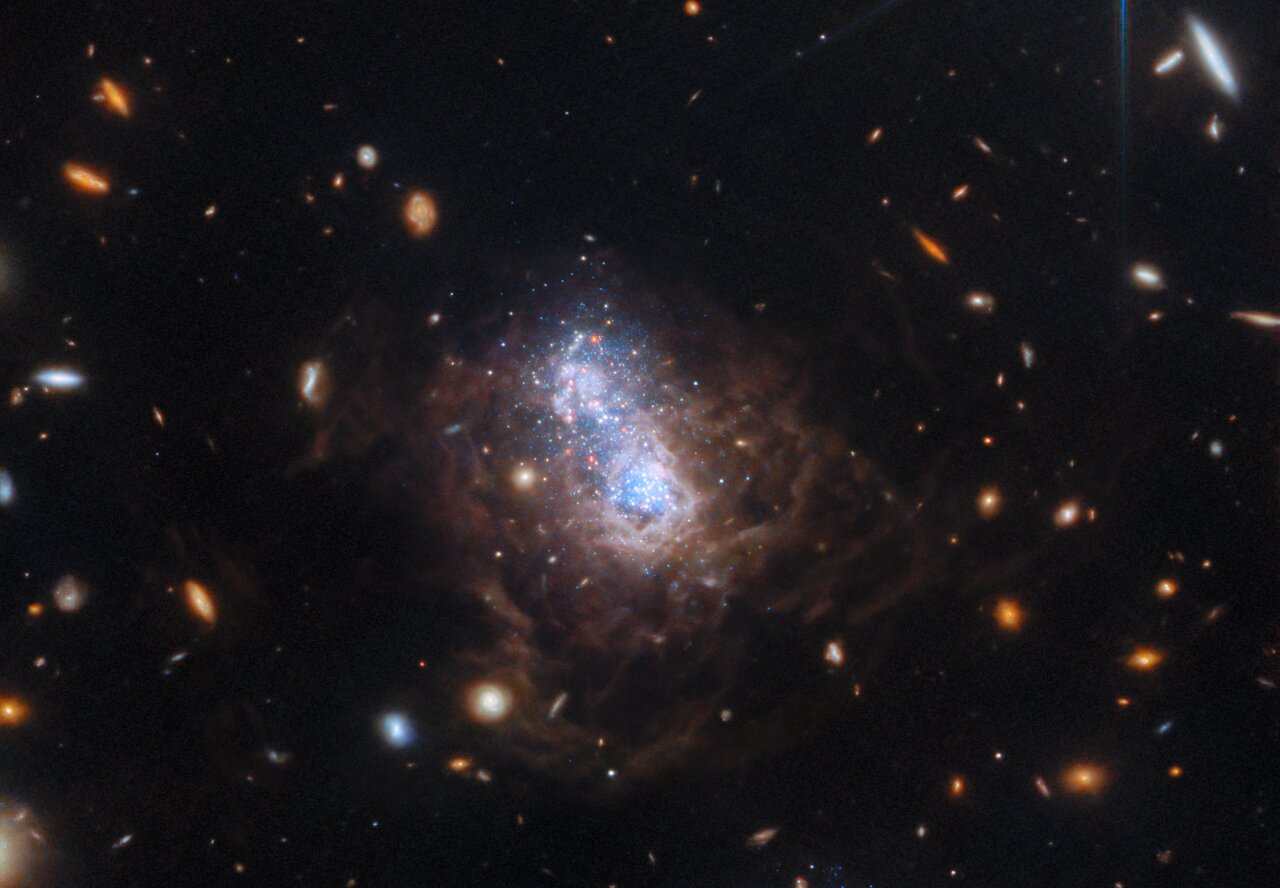About the Object
| Name: | I Zw 18 | |
|---|---|---|
| Distance: |
59 million light years | |
| Constellation: | Ursa Major | |
| Category: | Galaxies NIRCam Picture of the Month | |
Coordinates
| Position (RA): | 9 34 2.35 |
|---|---|
| Position (Dec): | 55° 14' 27.44" |
| Field of view: | 1.03 x 0.72 arcminutes |
| Orientation: | North is 113.5° right of vertical |
Colours & filters
| Band | Wavelength | Telescope |
|---|---|---|
| Infrared | 1.15 μm | James Webb Space Telescope NIRCam |
| Infrared | 2.0 μm | James Webb Space Telescope NIRCam |
| Infrared | 3.56 μm | James Webb Space Telescope NIRCam |
| Infrared | 4.44 μm | James Webb Space Telescope NIRCam |
A duo of starbursts in I Zwicky 18
The NASA/ESA/CSA James Webb Space Telescope has captured a spectacular view of the galaxy I Zwicky 18 (I Zw 18) in this new image. The galaxy was first identified by Swiss astronomer Fritz Zwicky in the 1930’s and resides roughly 59 million light-years from Earth.
This galaxy has gone through several sudden bursts of star formation. This galaxy is typical of the kinds of galaxies that inhabited the early Universe and it is classified as a dwarf irregular galaxy (much smaller than our Milky Way).
Two major starburst regions are embedded in the heart of the galaxy. The wispy brown filaments surrounding the central starburst region are bubbles of gas that have been heated by stellar winds and intense ultraviolet radiation unleashed by hot, young stars. A companion galaxy resides nearby to the dwarf galaxy, which can be seen at the bottom of the wider-field image. The companion may be interacting with the dwarf galaxy and may have triggered that galaxy's recent star formation. The orange blobs surrounding the dwarf galaxy are the dim glow from ancient fully formed galaxies at much larger distances.
This image was taken as part of a Webb programme to study the life cycle of dust in I Zw 18. Scientists are now building off of previous research with Hubble obtained at optical wavelengths, studying individual dusty stars in detail with Webb’s equivalent spatial resolution and sensitivity at infrared wavelengths. This galaxy is of particular interest as its content of elements heavier than helium is one of the lowest of all known galaxies in the local Universe. Such conditions are thought to be similar to those in some of the first star-forming galaxies at high redshift, so the Webb study of I Zw 18 should shed light on the life-cycle of stars and dust in the early Universe.
Although previously believed to have only just recently begun forming its first generation of stars, the NASA/ESA Hubble Space Telescope found fainter, older red stars contained within the galaxy, suggesting its star formation started at least one billion years ago and possibly as much as 10 billion years ago. The galaxy, therefore, may have formed at the same time as most other galaxies.
The new observations from Webb have revealed the detection of a set of candidate dusty evolved stars. It also provides details about Zw 18’s two dominant star-forming regions. Webb’s new data suggest that the dominant bursts of star formation in these regions occurred at different times. The strongest starburst activity is now believed to have happened more recently in the northwest lobe as compared to the galaxy’s southeast lobe. This is based on the relative populations of younger versus older stars found in each of the lobes.
[Image Description: Many small galaxies are scattered on a black background: mainly, white, oval-shaped and red, spiral galaxies. The image is dominated by a dwarf irregular galaxy, which hosts a bright region of white and blue stars at its core that appear as two distinct lobes. This region is surrounded by brown dusty filaments.]
Links
- I Zw 18 (wide-field image)
- Video: Pan of I Zw 18
- Science paper (note: this paper highlights Webb's science in progress, which is currently going through the peer-review process)
ESA/Webb, NASA, CSA, A. Hirschauer, M. Meixner et al.
About the Image
| Id: | potm2403a | |
|---|---|---|
| Type: | Observation | |
| Release date: | 26 March 2024, 10:00 | |
| Size: | 2004 x 1391 px | |




